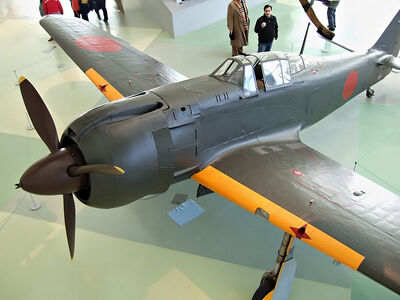(Adding categories) |
(Adding categories) |
||
| Line 11: | Line 11: | ||
[[Category:Fighters]] |
[[Category:Fighters]] |
||
[[Category:World War II]] |
[[Category:World War II]] |
||
| + | [[Category:Japanese Aircraft]] |
||
| + | [[Category:Propeller aircraft]] |
||
Revision as of 20:54, 19 December 2012
The Kawasaki Ki-100 was a fighter aircraft of the Japanese Imperial Army Air Force, that was used in World

War II. Its Army designation was Army Fighter Type 5 (五式戦闘機).
Alongside with the Ki-84 Hayate the Ki-100 was one of the best Fighter aircraft in World War II. It was developed from the Kawasaki Ki-61-II-KAI and was powered by a Mitsubishi-Ha112-II-radial engine with a power of 1120 kW. The first flight was on 1st February 1945 and it entered service in March of the same year. The last derivative, the Ki-100-Ib, was used in the last few weeks of the War.
Development
In the middle of the year 1944, the Kawasaki Ki-61 was developed, it was powered by a reconstructed Daimler-Benz DB-601 engine, the problem was that it became inferior to the American fighters, because of a too weak engine and the engineers had trouble with upgrading it. So that this engine was replaced by the Kawasaki-Ha-140-engine with a power of 1120 kW, this aircraft was now called Ki-61-II. Because of this conversion the Ki-61-II was now able to reach a top speed of 610 km/h. But production of the engine was interrupted by the allied bombing raids. The 280 remaining Ki-61 fuselages were now equipped with the Mitsubishi Ha-112-H-radial engine, also having a power of 1120 kW and were called Ki-100.
One month after the first flight, which took place on 1st February 1945, the first aircraft entered operational status. The Japanese General Staff was quite pleased with the excellent performance of the Ki-100. After some modifications the Ki-100-1a was developed, 272 Ki-100 were upgraded to the Ki-100-1a design. Some more modifications led to the Ki-100-Ib.